Business Law and Ethics: Case Studies and Legal Analysis
VerifiedAdded on 2019/09/18
|10
|2439
|658
Report
AI Summary
The assignment content discusses various legal issues and case studies related to contracts. The cases involve issues such as non-performance of obligations, misrepresentation, tort of negligence, contract with a minor, contract with an incapacitated person, oral agreements, and breach of contract. In each case, the parties' rights and responsibilities are analyzed according to the Contract Act, and the legal implications are discussed.
Contribute Materials
Your contribution can guide someone’s learning journey. Share your
documents today.
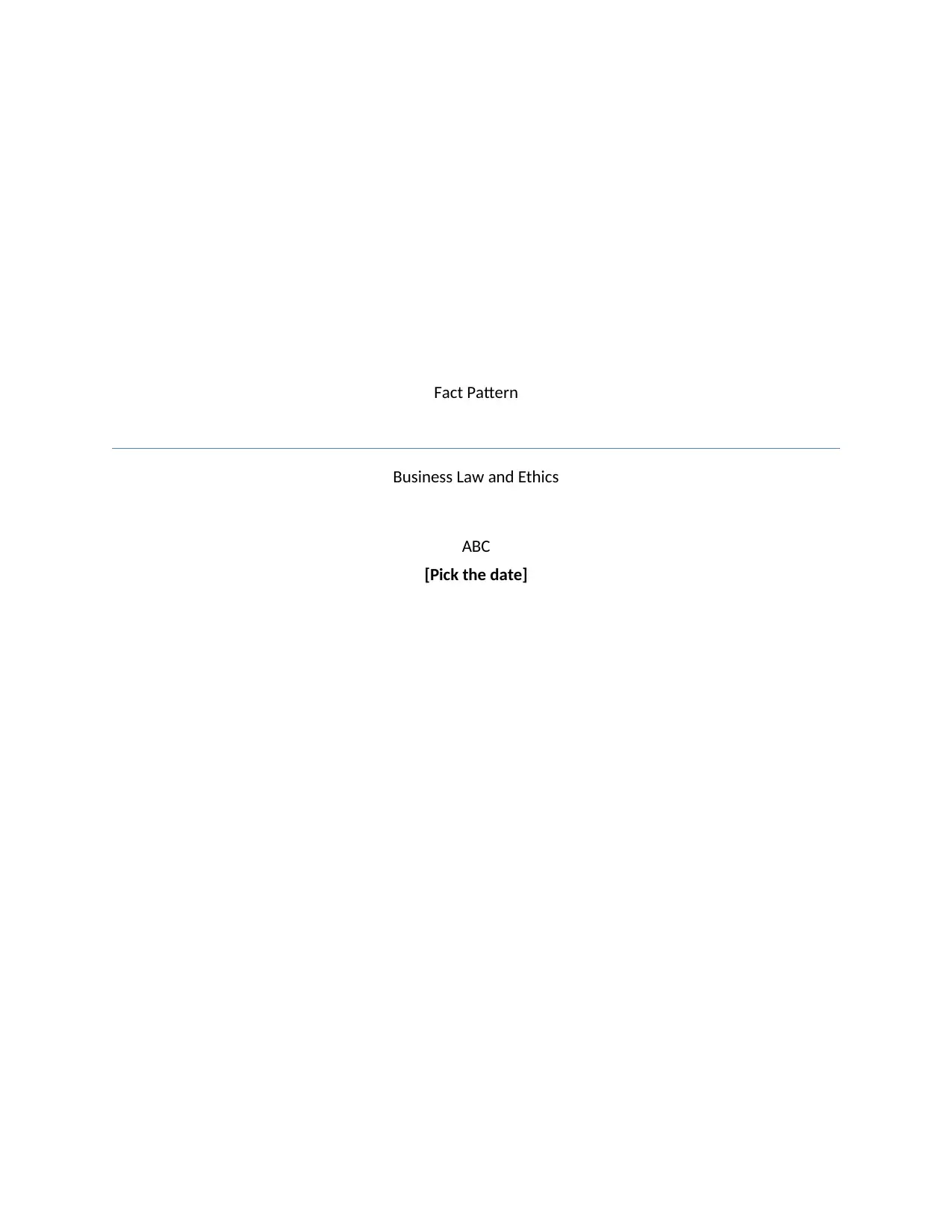
Fact Pattern
Business Law and Ethics
ABC
[Pick the date]
Business Law and Ethics
ABC
[Pick the date]
Secure Best Marks with AI Grader
Need help grading? Try our AI Grader for instant feedback on your assignments.
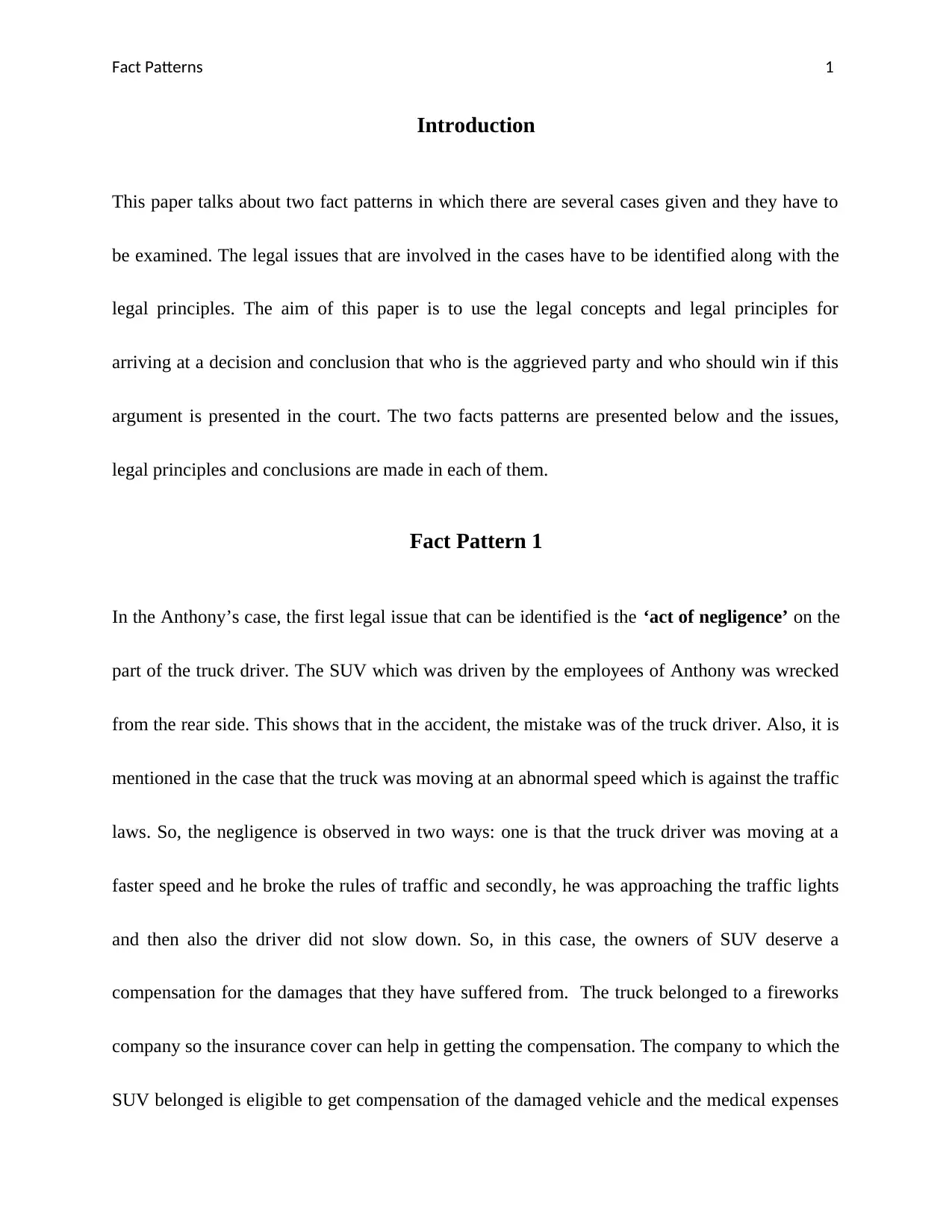
Fact Patterns 1
Introduction
This paper talks about two fact patterns in which there are several cases given and they have to
be examined. The legal issues that are involved in the cases have to be identified along with the
legal principles. The aim of this paper is to use the legal concepts and legal principles for
arriving at a decision and conclusion that who is the aggrieved party and who should win if this
argument is presented in the court. The two facts patterns are presented below and the issues,
legal principles and conclusions are made in each of them.
Fact Pattern 1
In the Anthony’s case, the first legal issue that can be identified is the ‘act of negligence’ on the
part of the truck driver. The SUV which was driven by the employees of Anthony was wrecked
from the rear side. This shows that in the accident, the mistake was of the truck driver. Also, it is
mentioned in the case that the truck was moving at an abnormal speed which is against the traffic
laws. So, the negligence is observed in two ways: one is that the truck driver was moving at a
faster speed and he broke the rules of traffic and secondly, he was approaching the traffic lights
and then also the driver did not slow down. So, in this case, the owners of SUV deserve a
compensation for the damages that they have suffered from. The truck belonged to a fireworks
company so the insurance cover can help in getting the compensation. The company to which the
SUV belonged is eligible to get compensation of the damaged vehicle and the medical expenses
Introduction
This paper talks about two fact patterns in which there are several cases given and they have to
be examined. The legal issues that are involved in the cases have to be identified along with the
legal principles. The aim of this paper is to use the legal concepts and legal principles for
arriving at a decision and conclusion that who is the aggrieved party and who should win if this
argument is presented in the court. The two facts patterns are presented below and the issues,
legal principles and conclusions are made in each of them.
Fact Pattern 1
In the Anthony’s case, the first legal issue that can be identified is the ‘act of negligence’ on the
part of the truck driver. The SUV which was driven by the employees of Anthony was wrecked
from the rear side. This shows that in the accident, the mistake was of the truck driver. Also, it is
mentioned in the case that the truck was moving at an abnormal speed which is against the traffic
laws. So, the negligence is observed in two ways: one is that the truck driver was moving at a
faster speed and he broke the rules of traffic and secondly, he was approaching the traffic lights
and then also the driver did not slow down. So, in this case, the owners of SUV deserve a
compensation for the damages that they have suffered from. The truck belonged to a fireworks
company so the insurance cover can help in getting the compensation. The company to which the
SUV belonged is eligible to get compensation of the damaged vehicle and the medical expenses
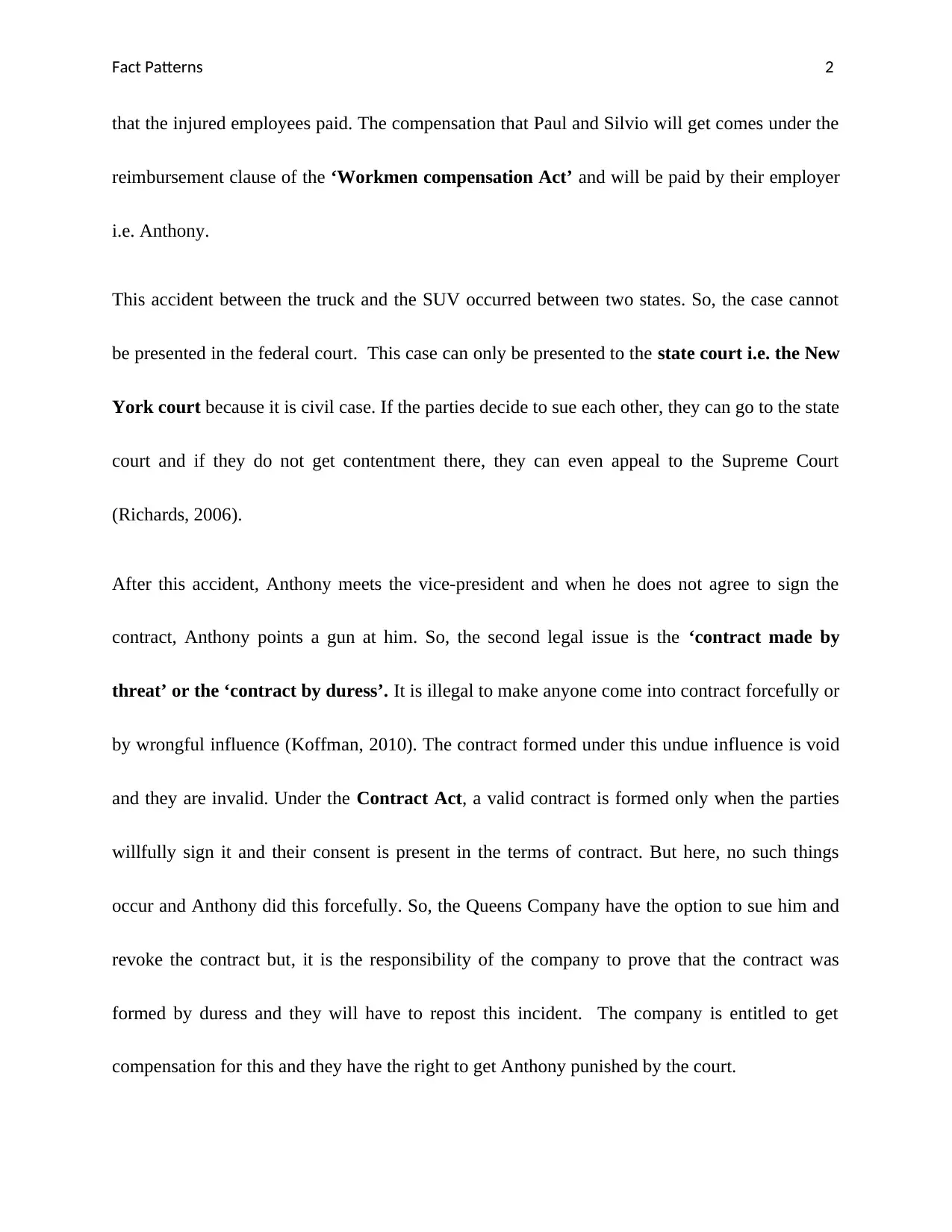
Fact Patterns 2
that the injured employees paid. The compensation that Paul and Silvio will get comes under the
reimbursement clause of the ‘Workmen compensation Act’ and will be paid by their employer
i.e. Anthony.
This accident between the truck and the SUV occurred between two states. So, the case cannot
be presented in the federal court. This case can only be presented to the state court i.e. the New
York court because it is civil case. If the parties decide to sue each other, they can go to the state
court and if they do not get contentment there, they can even appeal to the Supreme Court
(Richards, 2006).
After this accident, Anthony meets the vice-president and when he does not agree to sign the
contract, Anthony points a gun at him. So, the second legal issue is the ‘contract made by
threat’ or the ‘contract by duress’. It is illegal to make anyone come into contract forcefully or
by wrongful influence (Koffman, 2010). The contract formed under this undue influence is void
and they are invalid. Under the Contract Act, a valid contract is formed only when the parties
willfully sign it and their consent is present in the terms of contract. But here, no such things
occur and Anthony did this forcefully. So, the Queens Company have the option to sue him and
revoke the contract but, it is the responsibility of the company to prove that the contract was
formed by duress and they will have to repost this incident. The company is entitled to get
compensation for this and they have the right to get Anthony punished by the court.
that the injured employees paid. The compensation that Paul and Silvio will get comes under the
reimbursement clause of the ‘Workmen compensation Act’ and will be paid by their employer
i.e. Anthony.
This accident between the truck and the SUV occurred between two states. So, the case cannot
be presented in the federal court. This case can only be presented to the state court i.e. the New
York court because it is civil case. If the parties decide to sue each other, they can go to the state
court and if they do not get contentment there, they can even appeal to the Supreme Court
(Richards, 2006).
After this accident, Anthony meets the vice-president and when he does not agree to sign the
contract, Anthony points a gun at him. So, the second legal issue is the ‘contract made by
threat’ or the ‘contract by duress’. It is illegal to make anyone come into contract forcefully or
by wrongful influence (Koffman, 2010). The contract formed under this undue influence is void
and they are invalid. Under the Contract Act, a valid contract is formed only when the parties
willfully sign it and their consent is present in the terms of contract. But here, no such things
occur and Anthony did this forcefully. So, the Queens Company have the option to sue him and
revoke the contract but, it is the responsibility of the company to prove that the contract was
formed by duress and they will have to repost this incident. The company is entitled to get
compensation for this and they have the right to get Anthony punished by the court.
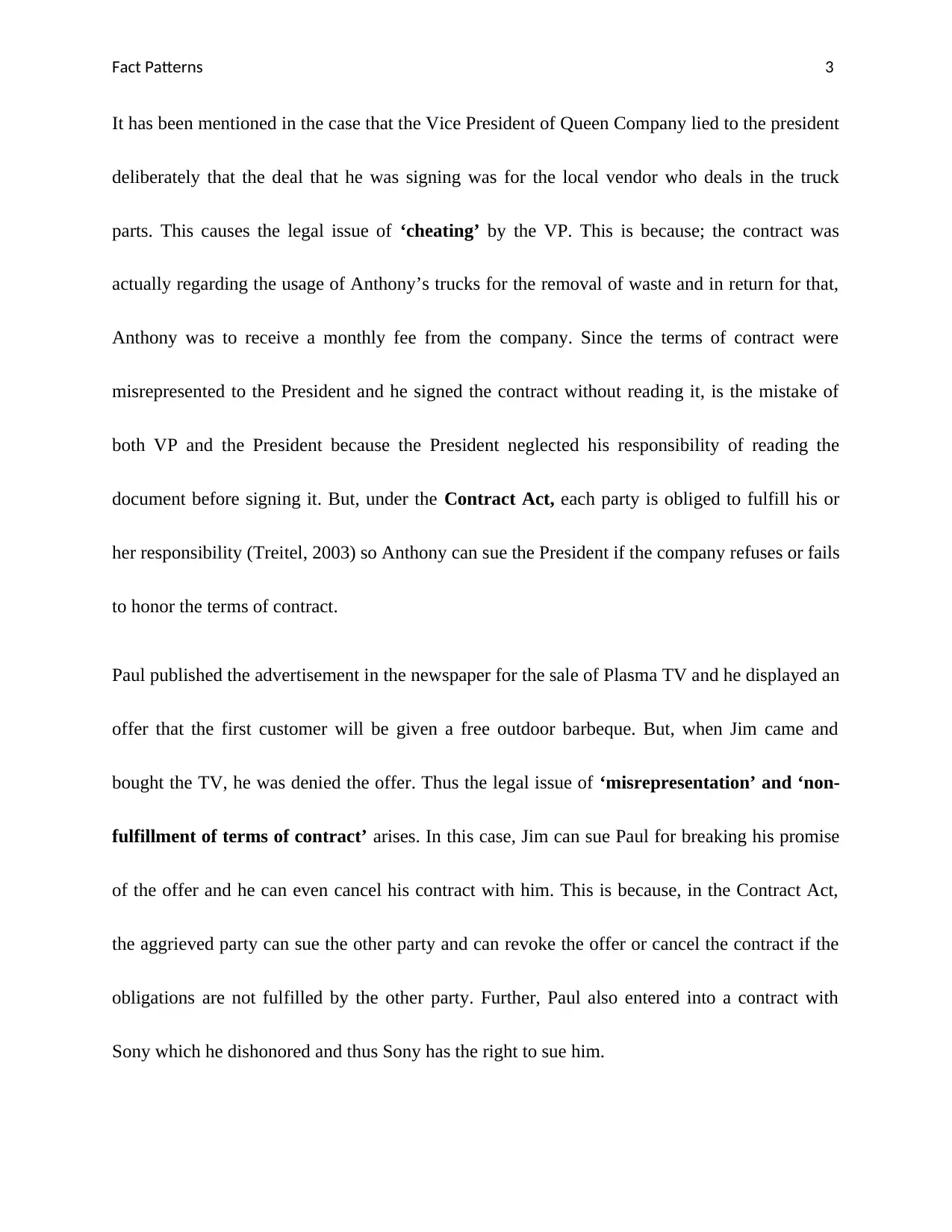
Fact Patterns 3
It has been mentioned in the case that the Vice President of Queen Company lied to the president
deliberately that the deal that he was signing was for the local vendor who deals in the truck
parts. This causes the legal issue of ‘cheating’ by the VP. This is because; the contract was
actually regarding the usage of Anthony’s trucks for the removal of waste and in return for that,
Anthony was to receive a monthly fee from the company. Since the terms of contract were
misrepresented to the President and he signed the contract without reading it, is the mistake of
both VP and the President because the President neglected his responsibility of reading the
document before signing it. But, under the Contract Act, each party is obliged to fulfill his or
her responsibility (Treitel, 2003) so Anthony can sue the President if the company refuses or fails
to honor the terms of contract.
Paul published the advertisement in the newspaper for the sale of Plasma TV and he displayed an
offer that the first customer will be given a free outdoor barbeque. But, when Jim came and
bought the TV, he was denied the offer. Thus the legal issue of ‘misrepresentation’ and ‘non-
fulfillment of terms of contract’ arises. In this case, Jim can sue Paul for breaking his promise
of the offer and he can even cancel his contract with him. This is because, in the Contract Act,
the aggrieved party can sue the other party and can revoke the offer or cancel the contract if the
obligations are not fulfilled by the other party. Further, Paul also entered into a contract with
Sony which he dishonored and thus Sony has the right to sue him.
It has been mentioned in the case that the Vice President of Queen Company lied to the president
deliberately that the deal that he was signing was for the local vendor who deals in the truck
parts. This causes the legal issue of ‘cheating’ by the VP. This is because; the contract was
actually regarding the usage of Anthony’s trucks for the removal of waste and in return for that,
Anthony was to receive a monthly fee from the company. Since the terms of contract were
misrepresented to the President and he signed the contract without reading it, is the mistake of
both VP and the President because the President neglected his responsibility of reading the
document before signing it. But, under the Contract Act, each party is obliged to fulfill his or
her responsibility (Treitel, 2003) so Anthony can sue the President if the company refuses or fails
to honor the terms of contract.
Paul published the advertisement in the newspaper for the sale of Plasma TV and he displayed an
offer that the first customer will be given a free outdoor barbeque. But, when Jim came and
bought the TV, he was denied the offer. Thus the legal issue of ‘misrepresentation’ and ‘non-
fulfillment of terms of contract’ arises. In this case, Jim can sue Paul for breaking his promise
of the offer and he can even cancel his contract with him. This is because, in the Contract Act,
the aggrieved party can sue the other party and can revoke the offer or cancel the contract if the
obligations are not fulfilled by the other party. Further, Paul also entered into a contract with
Sony which he dishonored and thus Sony has the right to sue him.
Secure Best Marks with AI Grader
Need help grading? Try our AI Grader for instant feedback on your assignments.
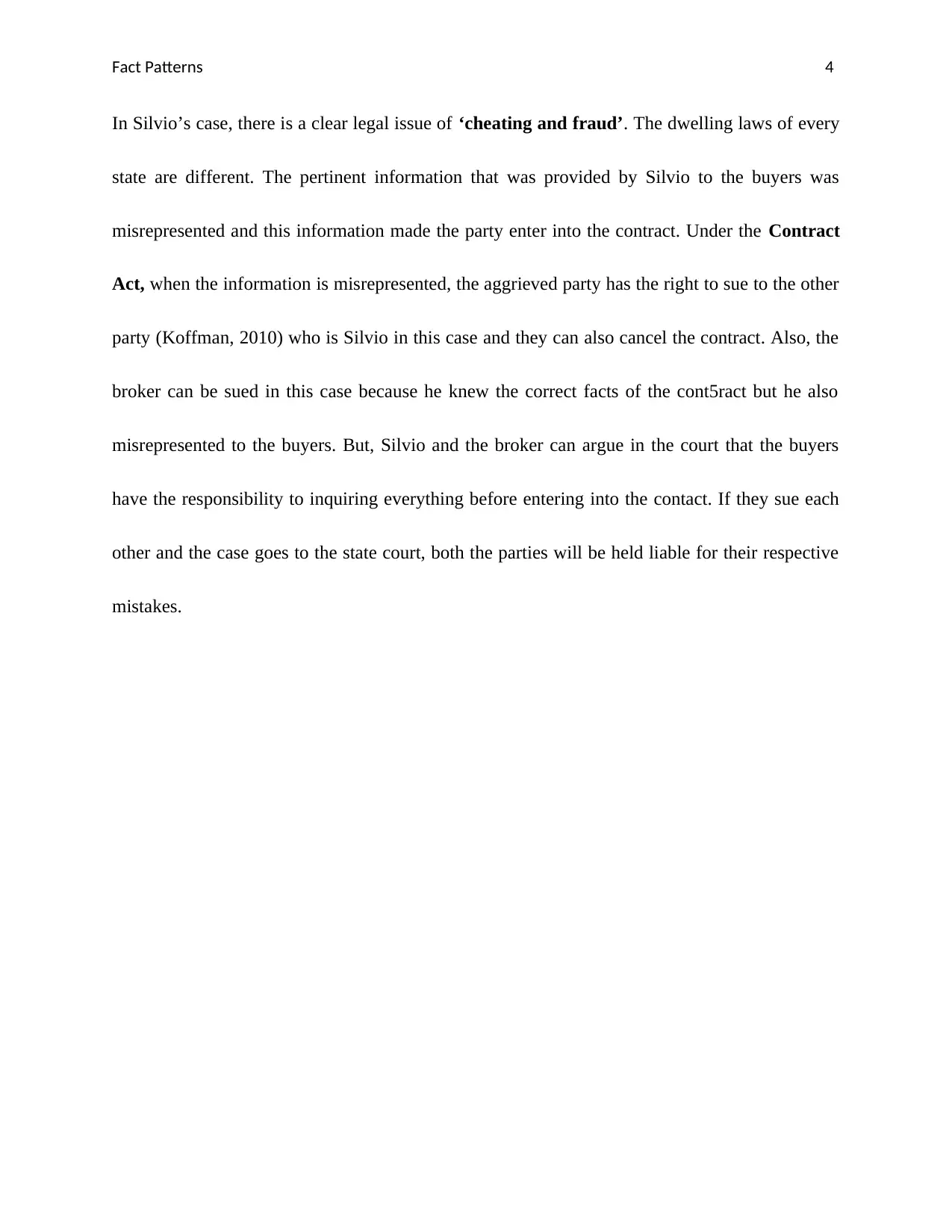
Fact Patterns 4
In Silvio’s case, there is a clear legal issue of ‘cheating and fraud’. The dwelling laws of every
state are different. The pertinent information that was provided by Silvio to the buyers was
misrepresented and this information made the party enter into the contract. Under the Contract
Act, when the information is misrepresented, the aggrieved party has the right to sue to the other
party (Koffman, 2010) who is Silvio in this case and they can also cancel the contract. Also, the
broker can be sued in this case because he knew the correct facts of the cont5ract but he also
misrepresented to the buyers. But, Silvio and the broker can argue in the court that the buyers
have the responsibility to inquiring everything before entering into the contact. If they sue each
other and the case goes to the state court, both the parties will be held liable for their respective
mistakes.
In Silvio’s case, there is a clear legal issue of ‘cheating and fraud’. The dwelling laws of every
state are different. The pertinent information that was provided by Silvio to the buyers was
misrepresented and this information made the party enter into the contract. Under the Contract
Act, when the information is misrepresented, the aggrieved party has the right to sue to the other
party (Koffman, 2010) who is Silvio in this case and they can also cancel the contract. Also, the
broker can be sued in this case because he knew the correct facts of the cont5ract but he also
misrepresented to the buyers. But, Silvio and the broker can argue in the court that the buyers
have the responsibility to inquiring everything before entering into the contact. If they sue each
other and the case goes to the state court, both the parties will be held liable for their respective
mistakes.
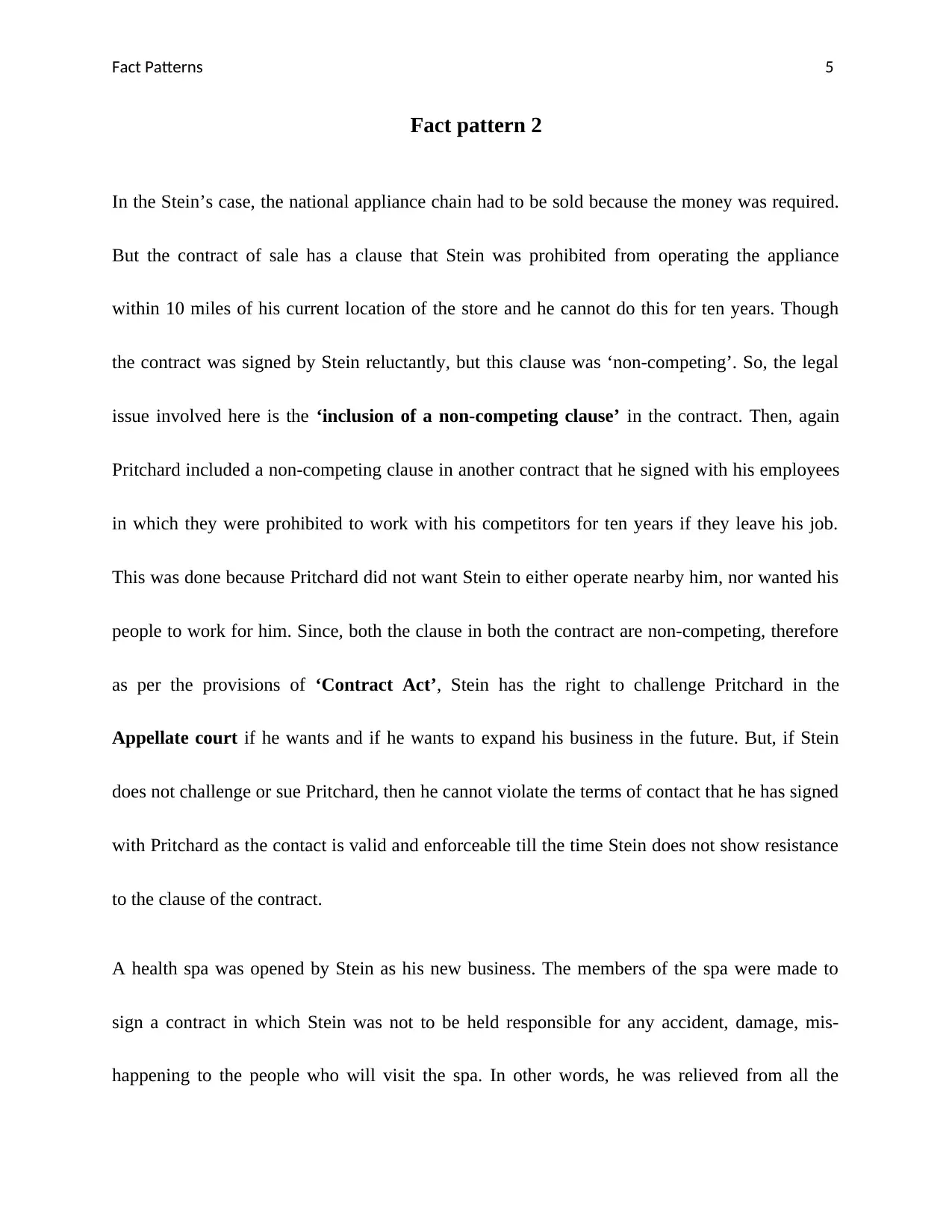
Fact Patterns 5
Fact pattern 2
In the Stein’s case, the national appliance chain had to be sold because the money was required.
But the contract of sale has a clause that Stein was prohibited from operating the appliance
within 10 miles of his current location of the store and he cannot do this for ten years. Though
the contract was signed by Stein reluctantly, but this clause was ‘non-competing’. So, the legal
issue involved here is the ‘inclusion of a non-competing clause’ in the contract. Then, again
Pritchard included a non-competing clause in another contract that he signed with his employees
in which they were prohibited to work with his competitors for ten years if they leave his job.
This was done because Pritchard did not want Stein to either operate nearby him, nor wanted his
people to work for him. Since, both the clause in both the contract are non-competing, therefore
as per the provisions of ‘Contract Act’, Stein has the right to challenge Pritchard in the
Appellate court if he wants and if he wants to expand his business in the future. But, if Stein
does not challenge or sue Pritchard, then he cannot violate the terms of contact that he has signed
with Pritchard as the contact is valid and enforceable till the time Stein does not show resistance
to the clause of the contract.
A health spa was opened by Stein as his new business. The members of the spa were made to
sign a contract in which Stein was not to be held responsible for any accident, damage, mis-
happening to the people who will visit the spa. In other words, he was relieved from all the
Fact pattern 2
In the Stein’s case, the national appliance chain had to be sold because the money was required.
But the contract of sale has a clause that Stein was prohibited from operating the appliance
within 10 miles of his current location of the store and he cannot do this for ten years. Though
the contract was signed by Stein reluctantly, but this clause was ‘non-competing’. So, the legal
issue involved here is the ‘inclusion of a non-competing clause’ in the contract. Then, again
Pritchard included a non-competing clause in another contract that he signed with his employees
in which they were prohibited to work with his competitors for ten years if they leave his job.
This was done because Pritchard did not want Stein to either operate nearby him, nor wanted his
people to work for him. Since, both the clause in both the contract are non-competing, therefore
as per the provisions of ‘Contract Act’, Stein has the right to challenge Pritchard in the
Appellate court if he wants and if he wants to expand his business in the future. But, if Stein
does not challenge or sue Pritchard, then he cannot violate the terms of contact that he has signed
with Pritchard as the contact is valid and enforceable till the time Stein does not show resistance
to the clause of the contract.
A health spa was opened by Stein as his new business. The members of the spa were made to
sign a contract in which Stein was not to be held responsible for any accident, damage, mis-
happening to the people who will visit the spa. In other words, he was relieved from all the
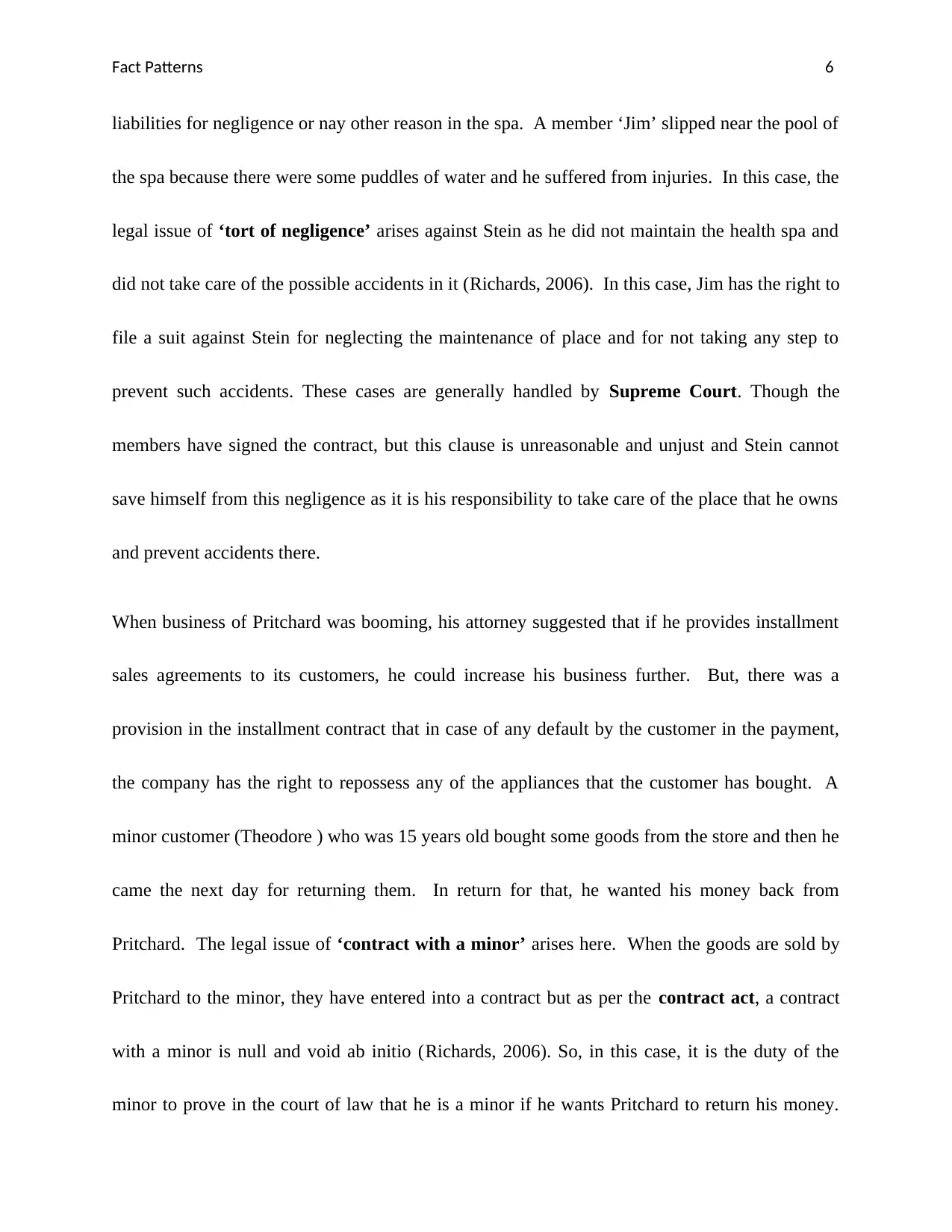
Fact Patterns 6
liabilities for negligence or nay other reason in the spa. A member ‘Jim’ slipped near the pool of
the spa because there were some puddles of water and he suffered from injuries. In this case, the
legal issue of ‘tort of negligence’ arises against Stein as he did not maintain the health spa and
did not take care of the possible accidents in it (Richards, 2006). In this case, Jim has the right to
file a suit against Stein for neglecting the maintenance of place and for not taking any step to
prevent such accidents. These cases are generally handled by Supreme Court. Though the
members have signed the contract, but this clause is unreasonable and unjust and Stein cannot
save himself from this negligence as it is his responsibility to take care of the place that he owns
and prevent accidents there.
When business of Pritchard was booming, his attorney suggested that if he provides installment
sales agreements to its customers, he could increase his business further. But, there was a
provision in the installment contract that in case of any default by the customer in the payment,
the company has the right to repossess any of the appliances that the customer has bought. A
minor customer (Theodore ) who was 15 years old bought some goods from the store and then he
came the next day for returning them. In return for that, he wanted his money back from
Pritchard. The legal issue of ‘contract with a minor’ arises here. When the goods are sold by
Pritchard to the minor, they have entered into a contract but as per the contract act, a contract
with a minor is null and void ab initio (Richards, 2006). So, in this case, it is the duty of the
minor to prove in the court of law that he is a minor if he wants Pritchard to return his money.
liabilities for negligence or nay other reason in the spa. A member ‘Jim’ slipped near the pool of
the spa because there were some puddles of water and he suffered from injuries. In this case, the
legal issue of ‘tort of negligence’ arises against Stein as he did not maintain the health spa and
did not take care of the possible accidents in it (Richards, 2006). In this case, Jim has the right to
file a suit against Stein for neglecting the maintenance of place and for not taking any step to
prevent such accidents. These cases are generally handled by Supreme Court. Though the
members have signed the contract, but this clause is unreasonable and unjust and Stein cannot
save himself from this negligence as it is his responsibility to take care of the place that he owns
and prevent accidents there.
When business of Pritchard was booming, his attorney suggested that if he provides installment
sales agreements to its customers, he could increase his business further. But, there was a
provision in the installment contract that in case of any default by the customer in the payment,
the company has the right to repossess any of the appliances that the customer has bought. A
minor customer (Theodore ) who was 15 years old bought some goods from the store and then he
came the next day for returning them. In return for that, he wanted his money back from
Pritchard. The legal issue of ‘contract with a minor’ arises here. When the goods are sold by
Pritchard to the minor, they have entered into a contract but as per the contract act, a contract
with a minor is null and void ab initio (Richards, 2006). So, in this case, it is the duty of the
minor to prove in the court of law that he is a minor if he wants Pritchard to return his money.
Paraphrase This Document
Need a fresh take? Get an instant paraphrase of this document with our AI Paraphraser
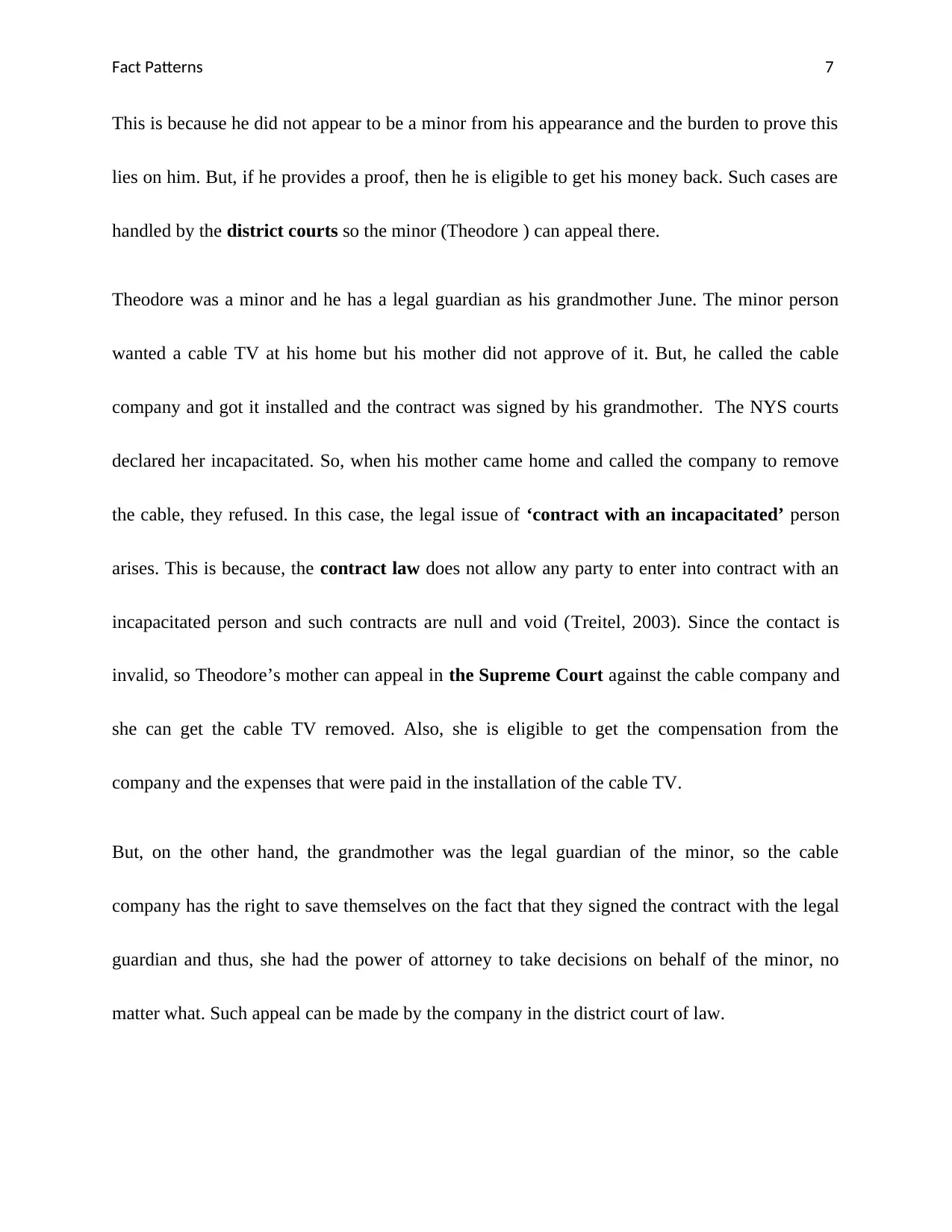
Fact Patterns 7
This is because he did not appear to be a minor from his appearance and the burden to prove this
lies on him. But, if he provides a proof, then he is eligible to get his money back. Such cases are
handled by the district courts so the minor (Theodore ) can appeal there.
Theodore was a minor and he has a legal guardian as his grandmother June. The minor person
wanted a cable TV at his home but his mother did not approve of it. But, he called the cable
company and got it installed and the contract was signed by his grandmother. The NYS courts
declared her incapacitated. So, when his mother came home and called the company to remove
the cable, they refused. In this case, the legal issue of ‘contract with an incapacitated’ person
arises. This is because, the contract law does not allow any party to enter into contract with an
incapacitated person and such contracts are null and void (Treitel, 2003). Since the contact is
invalid, so Theodore’s mother can appeal in the Supreme Court against the cable company and
she can get the cable TV removed. Also, she is eligible to get the compensation from the
company and the expenses that were paid in the installation of the cable TV.
But, on the other hand, the grandmother was the legal guardian of the minor, so the cable
company has the right to save themselves on the fact that they signed the contract with the legal
guardian and thus, she had the power of attorney to take decisions on behalf of the minor, no
matter what. Such appeal can be made by the company in the district court of law.
This is because he did not appear to be a minor from his appearance and the burden to prove this
lies on him. But, if he provides a proof, then he is eligible to get his money back. Such cases are
handled by the district courts so the minor (Theodore ) can appeal there.
Theodore was a minor and he has a legal guardian as his grandmother June. The minor person
wanted a cable TV at his home but his mother did not approve of it. But, he called the cable
company and got it installed and the contract was signed by his grandmother. The NYS courts
declared her incapacitated. So, when his mother came home and called the company to remove
the cable, they refused. In this case, the legal issue of ‘contract with an incapacitated’ person
arises. This is because, the contract law does not allow any party to enter into contract with an
incapacitated person and such contracts are null and void (Treitel, 2003). Since the contact is
invalid, so Theodore’s mother can appeal in the Supreme Court against the cable company and
she can get the cable TV removed. Also, she is eligible to get the compensation from the
company and the expenses that were paid in the installation of the cable TV.
But, on the other hand, the grandmother was the legal guardian of the minor, so the cable
company has the right to save themselves on the fact that they signed the contract with the legal
guardian and thus, she had the power of attorney to take decisions on behalf of the minor, no
matter what. Such appeal can be made by the company in the district court of law.
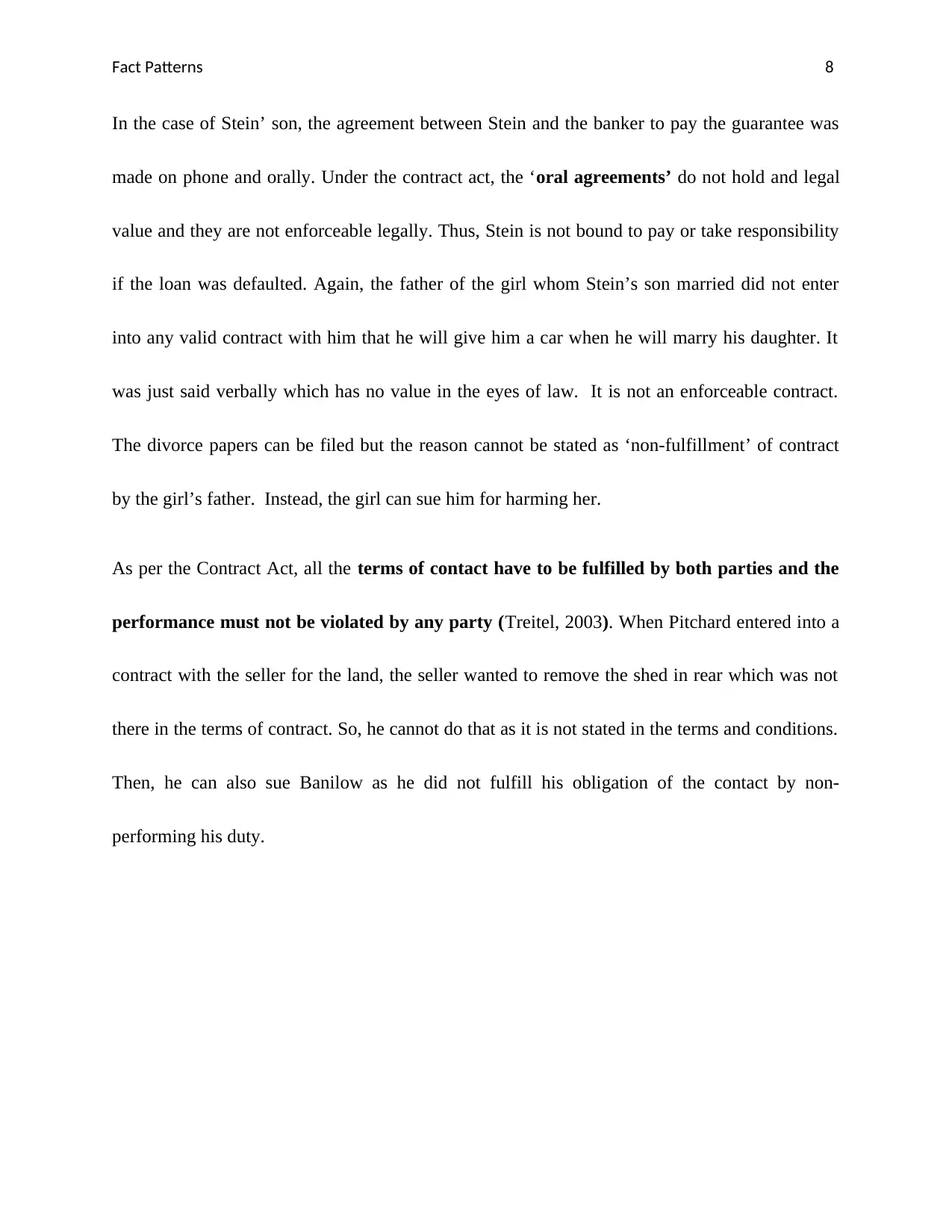
Fact Patterns 8
In the case of Stein’ son, the agreement between Stein and the banker to pay the guarantee was
made on phone and orally. Under the contract act, the ‘oral agreements’ do not hold and legal
value and they are not enforceable legally. Thus, Stein is not bound to pay or take responsibility
if the loan was defaulted. Again, the father of the girl whom Stein’s son married did not enter
into any valid contract with him that he will give him a car when he will marry his daughter. It
was just said verbally which has no value in the eyes of law. It is not an enforceable contract.
The divorce papers can be filed but the reason cannot be stated as ‘non-fulfillment’ of contract
by the girl’s father. Instead, the girl can sue him for harming her.
As per the Contract Act, all the terms of contact have to be fulfilled by both parties and the
performance must not be violated by any party (Treitel, 2003). When Pitchard entered into a
contract with the seller for the land, the seller wanted to remove the shed in rear which was not
there in the terms of contract. So, he cannot do that as it is not stated in the terms and conditions.
Then, he can also sue Banilow as he did not fulfill his obligation of the contact by non-
performing his duty.
In the case of Stein’ son, the agreement between Stein and the banker to pay the guarantee was
made on phone and orally. Under the contract act, the ‘oral agreements’ do not hold and legal
value and they are not enforceable legally. Thus, Stein is not bound to pay or take responsibility
if the loan was defaulted. Again, the father of the girl whom Stein’s son married did not enter
into any valid contract with him that he will give him a car when he will marry his daughter. It
was just said verbally which has no value in the eyes of law. It is not an enforceable contract.
The divorce papers can be filed but the reason cannot be stated as ‘non-fulfillment’ of contract
by the girl’s father. Instead, the girl can sue him for harming her.
As per the Contract Act, all the terms of contact have to be fulfilled by both parties and the
performance must not be violated by any party (Treitel, 2003). When Pitchard entered into a
contract with the seller for the land, the seller wanted to remove the shed in rear which was not
there in the terms of contract. So, he cannot do that as it is not stated in the terms and conditions.
Then, he can also sue Banilow as he did not fulfill his obligation of the contact by non-
performing his duty.
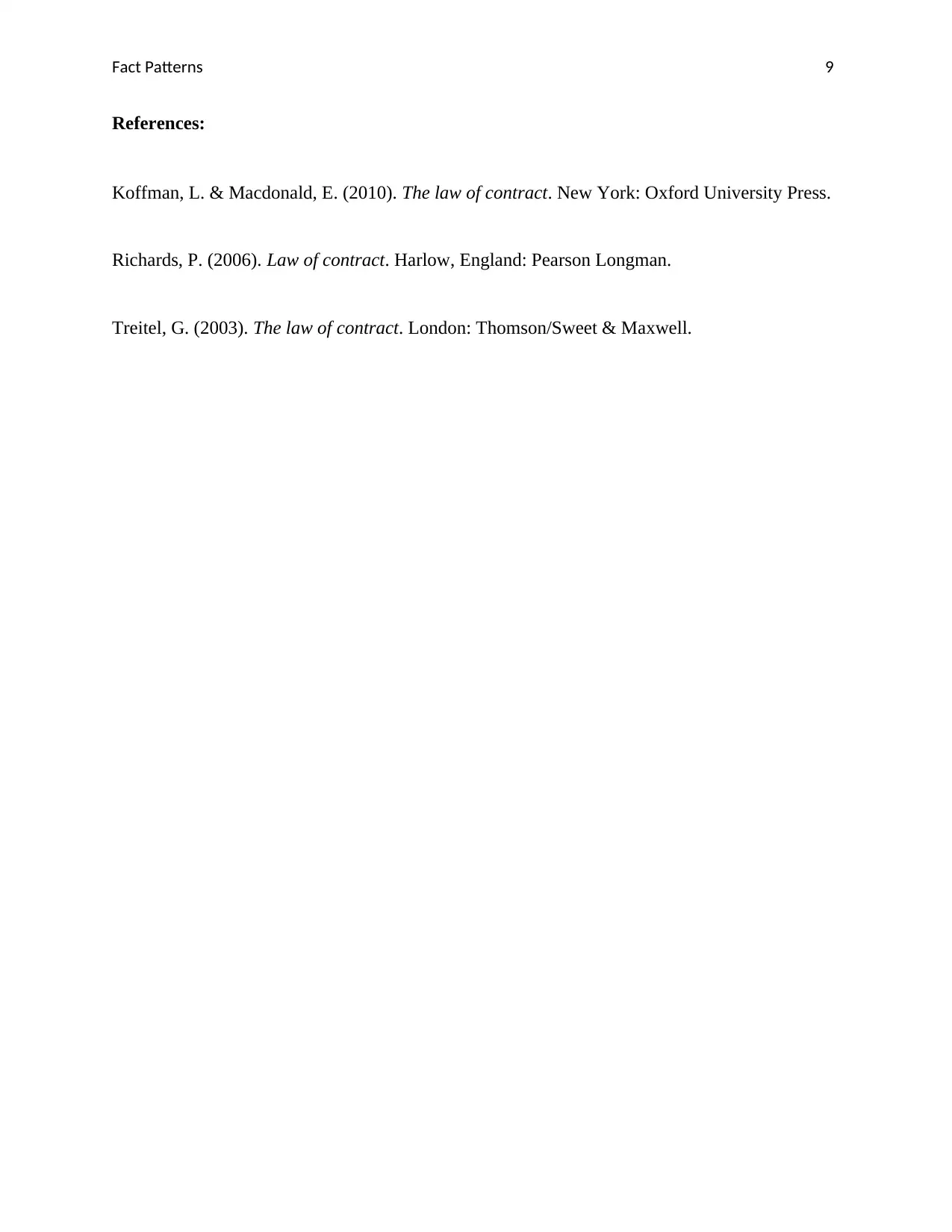
Fact Patterns 9
References:
Koffman, L. & Macdonald, E. (2010). The law of contract. New York: Oxford University Press.
Richards, P. (2006). Law of contract. Harlow, England: Pearson Longman.
Treitel, G. (2003). The law of contract. London: Thomson/Sweet & Maxwell.
References:
Koffman, L. & Macdonald, E. (2010). The law of contract. New York: Oxford University Press.
Richards, P. (2006). Law of contract. Harlow, England: Pearson Longman.
Treitel, G. (2003). The law of contract. London: Thomson/Sweet & Maxwell.
1 out of 10
Related Documents
Your All-in-One AI-Powered Toolkit for Academic Success.
+13062052269
info@desklib.com
Available 24*7 on WhatsApp / Email
![[object Object]](/_next/static/media/star-bottom.7253800d.svg)
Unlock your academic potential
© 2024 | Zucol Services PVT LTD | All rights reserved.





